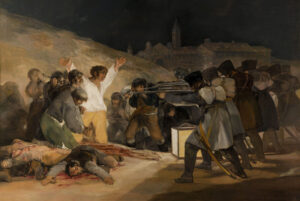At the 1914 Battle of the Marne, resolute French soldiers were finally able to stop Germany’s relentless march with a little help from ‘Mademoiselle Soixante-quinze.’
The once proud French army dug itself out of the rubble of the Franco-Prussian War about as demoralized as a fighting force could be. The noble heritage of Napoleon’s legions was in tatters; France’s soldiers had been buried by breechloading Krupp artillery made of crucible steel that was a full generation ahead of the sorry Gallic muzzleloaders made of bronze. France’s only answer to Germany’s technological advances–the Mitrailleuse, a multibarreled Gatling-type machine gun kept so secret that virtually no one knew how to operate it–had proven to be an illusory panacea. Used for some reason as artillery, it, too, was shattered by the relentless German cannons. The experience left an indelible stain on France’s honor and a determination among her soldiers never to be outgunned again.
One byproduct of the Franco-Prussian War was that field artillery emerged as the queen of battle and was continuing to improve by leaps and bounds. A cascade of innovations-nitrocellulosic “smokeless” propellant, high explosives, standardized unitary cartridges, quick-loading breeches, and still stronger barrels-was revolutionizing the middleweight class of guns (60-80mm) used with and against maneuvering infantry. Within two decades the best of these guns were technically capable of letting loose six to eight rounds per minute–yet the word “technically ” left substantial room for error. Field artillery in particular was bedeviled by Newton’s Third Law of Motion, which meant that for every shot there was an equal and opposite recoil pushing any gun rigidly attached to its carriage at least several feet backward. Thus “quick firing” inevitably meant wild and inaccurate firing. For accurate shots, the gunners had to manhandle the piece back to its proper position and re-aim it.
The solution clearly lay with devices that could deal with the shock–at first rudimentary artifices such as rubber pads and springs and ultimately hydraulic-based mechanisms of varying degrees of sophistication. Rapid progress was made with fixed coastal guns and truly heavy artillery, where weight and complexity were of little consequence. But since field guns had to be moved quickly and were subject to all the mischief that dust and mud could inflict on moving parts, change came slowly for them. By 1890 the state of the art consisted of fairly simple combinations of hydraulics and springs, which first checked the motion of the barrel and then brought it back to firing position, all in the space of several inches. Field guns still jumped back, but not as violently, and tests indicated they were much improved. Most powers, including the technically progressive Germans, were relatively satisfied.
But not the French, who longed for an instrument of revenge–a “dream gun” capable of delivering up to 20 aimed rounds a minute. Still faster acting breech designs would make this feasible, if only a way could be found to keep the gun still. In 1892, the director of French artillery, General Charles Mathieu, acting on purloined secret data, asked the heads of the country’s arsenals if it would be possible to design such a gun around a new long-recoil principle: Rather than inches, the barrel would be allowed to move several feet in a special cradle. The answer to this question was “Non, mon general,” until Colonel Alfred Deport, head of the Chantillon-Commentry gun foundry at Puteaux, agreed to accept the task. The work began in utmost secrecy without contract or ministerial approval, funded with a total of $60 million dollars supposedly earmarked for the purchase of property around Paris.
Everything turned on the development of the recoil mechanism.The work was supervised by Captain Sainte-Claire Deville, a gifted and relentless engineer. The principles for the mechanism were borrowed from a hydropneumatic brake and recuperator devised by a Belgian inventor. They seemed sound, but so great were the pressures involved that the first examples, cast in bronze, oozed glycerin hydraulic fluid through the very pores of the metal. This was corrected by using machined steel, and, gradually, problem by problem, solutions were found until the indefatigable Deville and his team brought the revolutionary 75mm gun to fruition in 1897.
The performance of the recoil system was astonishing. It was subsequently calculated that the energy released to the barrel upon firing was equal to that of an automobile traveling at 100 mph, which was then stopped within a space of three feet. The action reversed 15 or more times a minute, all without the slightest jar. A glass of water placed on one of the gun’s wheels in the midst of operation would not spill.
Not only would the gun fire accurately as fast as rounds could be slapped into its Nordenfeld-type, rotating-screw breech block, but its steadiness allowed the crew of four to gather closely enough around it to make the addition of an armored shield against small-arms fire a useful safety measure. Further rounding out the gun-officially designated the Mle-1897, but forever remembered by French soldiers as “la bonne soixante-quinze” (“the good 75”)– was a newly designed caisson built to pivot off its carriage and open like a cup board to provide ready access to 72 rounds. The rounds could then be dropped, two at a time, into a special device that automatically set time fuzes in a matter of two seconds, thereby providing what amounted to an uninterrupted ammunition flow to the gun. Everything that might slow the gun’s volcanic rate of fire was swept vigorously away.
The results spoke for themselves. In one minute, a single gun weighing just over 2,500 pounds was capable of spewing 15 precisely aimed 75mm high-explosive or shrapnel shells up to a distance of five miles, while a standard battery of four of the guns might rain 300 such shells on a body of troops at a similar range in just five minutes. It was no wonder the French concluded that they had in their hands a super gun, rendering obsolete not only every other field gun in the world, but also entire classes of artillery ranging from howitzers to truly heavy pieces. The “75” could do it all.
As might be expected, the French were determined to protect “Mademoiselle Soixante-quinze’s” privacy. A veil of secrecy descended, ensuring that no figures on ranges, rates of fire, weight of shells, or anything else would be released, and long prison terms were provided for those unauthorized souls who sought out such in formation. The curtain that surrounded the recoil mechanism was especially thick. Production of parts was deliberately scattered around France, and no one except those few trusted individuals responsible for final assembly actually knew what went on inside the recoil mechanism. Out in the field, regulations carefully stipulated which parts of the 75 might be disassembled, and stripping the recuperator was strictly forbidden.
Around the world rumors and mis information about the gun’s capabilities abounded. The Germans, stuck with their slow-firing 77mm fieldpiece and having obtained a secret photo of the new French gun, attempted to laugh it off as resembling a giant “cigar holder.” Others erred in the opposite direction, attributing to the 75 a range in excess of 10 miles, shrapnel shells whose balls could penetrate anything, and a high-explosive round of absolutely devastating capabilities. In the face of all this, the French managed to produce and deploy well over 4,000 75s during the 15 years prior to World War I while still holding the basic secrets of the weapon tightly in their grasp. So, as the guns of August 1914 unlimbered to fight, the 75 largely remained an unknown quantity.
Nothing like the disaster of the Mitrailleuse befell the 75, but it was nonetheless victimized by the evolving nature of the Great War itself. As long as the conflict remained fluid, the gun was devastating against Germans caught out in the open. Thus a single battery firing shrapnel shells into a beet field near Nanteuil-le-Haudouin managed to mow down more than two thousand members of the Lepe! Brigade in a matter of five minutes. At the Battle of the Marne, the effects of la bonne soixante quinze likely saved Paris and perhaps France itself from defeat. But from that point on, the gun became a victim of its own success, playing a major role in the German deci sion to dig in, and thereby setting up the conditions for trench warfare along the en tire Western Front. In trench warfare the 75’s decidedly flat trajectory was a distinct disadvan tage. Plunging fire, such as might be delivered by a howitzer, was known to be most efficacious against trenches.
Yet the French were slow to react, and when they did , the results reflected their loyalty and gratitude to Mademoiselle Soixante-quinze. Rather than appropriating funds for a proper howitzer, the French Assembly, at the suggestion of one Mon sieur Malandr in, recommended clipping a flat disc (une plaquette) around the fuse to interrupt the shell’s aerodynamics, giving it a steeper angle of descent. It never worked that well, but the prestige of the 75 was sufficient to fend off more viable alternatives. It had become an article of faith to the proud French that the Mle-1897 was the best art illerypiece in the world.
It is no surprise that when the United States at last joined the Allied war effort they opted to employ the 75, but they wanted to produce it at home. The French, on the edge of collapse, reluctantly agreed. But still they clung to the secret of the recuperator, which they offered to supply themselves. When the Americans refused, the French so indoctrinated the U.S. Army ordnance officer, sent to the arsenal at Puteaux to see how the mechanism was made, that upon his return he locked the plans in a safe and made himself unavailable for a month . “I guess the French would sooner lose the war than lose the secret of the 75,” one exasperated officer was heard to say.
A break finally came when, under some what murky circumstances, the artillery officer training program received four worn-out 75s as training tools. The guns soon found their way to the Ordnance Department, where they were torn apart. After disassembling the guns, the army’s chief of artillery was telephoned and told that the secret of the 75’s recuperator was nothing more than incredibly close tolerances–no tolerances, actually. Each and every example had been handmade by French craftsmen, working with the precision of jewelers.
Characteristically, the Americans chose mass production even after the French warned them it was impossible. It took time (in fact, the war was over), but the Singer Manufacturing Company, with exhausting attention to detail, finally managed to fabricate acceptable recuperators based on machine-made interchangeable parts. According to artillery historian Frank Comparato, the project “was one of the most complicated engineering tasks ever attempted…one of the marvels of modern industry.” Singer’s employees had every reason to celebrate. It is not known whether the French, when they heard of the feat, shared their joy. MHQ
ROBERT L. O’CONNELL is an MHQ contributing editor.
[hr]
This article originally appeared in the Winter 2001 issue (Vol. 13, No. 2) of MHQ—The Quarterly Journal of Military History with the headline: The Miraculous 75mm Gun
Want to have the lavishly illustrated, premium-quality print edition of MHQ delivered directly to you four times a year? Subscribe now at special savings!





